So, You Want To Fly

Dave Restell
I joined Bretons some time ago now to learn to fly RC fixed wing aircraft and have been asked to write about the process of learning to fly at Bretons Model Flying Club.
I had built and flown a rubber powered model aircraft when I was boy some 50 years ago now with a bit more time on my hands decided to learn to fly radio-controlled aircraft.
After a bit of reading and asking a few questions the best piece of advice that I got to ensure success was to join a club. It did seem a bit daunting being a newbie when some of the guys have been flying for many years.
I got in touch with our secretary asking if I could visit and was welcomed with a “Just come over when it’s not too windy and not raining”. I did visit Bretons Model Flying Club a few times and was made most welcome and joined a few weeks later.
If you are thinking of visiting the local clubs in your area. It may be good to ask first just in case there is anything you need to know like parking, locked gates, fields full of raging bulls etc. The answer will always be no problem come along.
At Bretons Model Flying Club being on a local authority ground there are no problems for visitors as there is a free car park that is a short walk from our flying area.
You can just pop over any afternoon just for a look or ask any questions you will be more than welcome, and you can also bring your kids if they would like to see the airplanes flying but obviously you need to ensure they stay in a safe area which you will be advised of by any of the club members and always supervised.

Hopefully you will be able to meet some of our instructors for a chat as you will be spending a lot of time with them in the coming months.
Try to find when they normally fly, as all instruction is free you will need to fit into their schedule and not forgetting they will want to fly their own planes.
Ask as many questions as you like it’s all free the guys just love talking about their hobby.
When visiting airfields try to find out what they fly, when they fly, look at the size of the airfield, are there trees to hit or ponds or rivers to land in?
Any of the members at Bretons Model Flying Club will advise you of any hazards that you would need to be aware of.
Big sites are best when learning to fly, we are lucky at Bretons Model Flying Club as we have an enormous space but with a dedicated landing and take-off area and pit area.
For all members to our club the training is free and all the BMFA membership and certification is included in the membership fee.
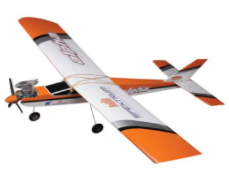
Training is given with our very experienced team of enthusiastic flying instructors.
With years of experience, they are very willing to teach you to fly. Some of the instructors are over the airfield during the week and others are around weekends and holidays this gives your training as much flexibility as possible.
Bretons Model Flying Club is an affiliated club of the British Model Flying Association (BMFA) so all the training given meets their very high standard with recognised Certificates issued when you reach the (BMFA) standard. With membership also comes third party insurance that covers you to fly anywhere in the world.
Getting Your Kit
When deciding what kit to get best advice is to keep it simple as possible. Your airplane will fly no problem, but it will need to be suitable for you to be taught how to fly.
When you are learning to fly you will need an aeroplane that is very easy to fly and kit that is simple to operate. The more distractions you have the longer it will take you to learn.
Here at Bretons Model Flying Club we have a Facebook page with a bunch of guys with tons of knowledge very helpful if you get stuck when preparing your airplane or setting up your radio gear.
Aircraft
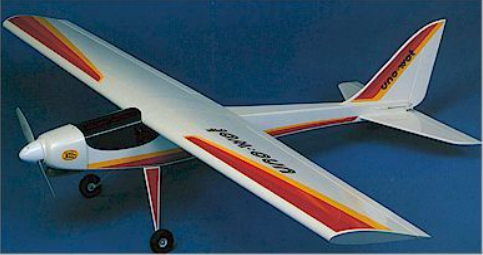
A High wing trainer with good landing gear – easy to fly and land. I was recommended a Boomerang that has turned out to be a very good choice. Obviously, there are other models that would also be suitable so ask our members or instructors for their advice before you go and buy any equipment of any sort.
Radio controlled aircraft come in many forms built and ready to fly (RTF), almost ready to fly (ARF) or kit.
The best piece of advice I got was “don’t get attached to the aircraft by spending a lot of time and money on it just treat it as a tool to learn to fly”.
If you spend months building it and crash on you second flight you will probably at that point give up.
You do not necessarily need to buy a brand-new aircraft as there are plenty of second hand ones available that would be more then suitable to learn with and any of the club members or instructors will be only to pleased to offer you any advice you need in purchasing a second hand aircraft.
Motor
Unless you are planning to fly gliders you will need an engine to propel your beloved airplane you have two choices.
Internal Combustion (IC)
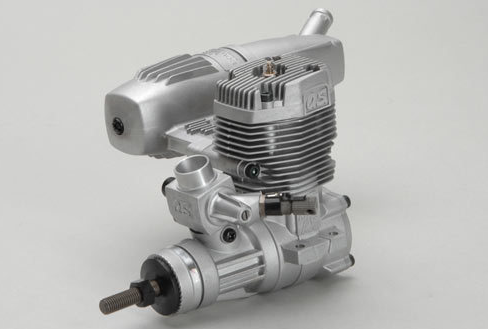
They have the advantage that they can fly all day, just fill up and take off. Some disadvantages are that some clubs have restrictions on flying times for IC flying because of noise or other factors – best advice is to ask a member for any restrictions that you may need to be aware of and comply with when learning.
They also can be temperamental and messy but in scale models it sounds like the real thing.
Electric

With big advances in battery technology over the last few years many models are now available as electric.
You can get a reasonable flight time but not always as much as IC. They do not make much noise so may not have so many restrictions on when and where to fly but you will still need to ask a club member to ensure that you will be aware of any restrictions on electric propelled aircraft.
At Bretons electric flight can start a couple of hours earlier during the week than IC. You will need a few batteries as they take around an hour to recharge.
I chose electric as it is the easiest route as you can be in the air within 10 minutes of arriving on site but obviously the choice is yours and you should speak to club members and instructors before buying so that you can then make the appropriate purchase based on the information and advice you are given.
Radio Gear
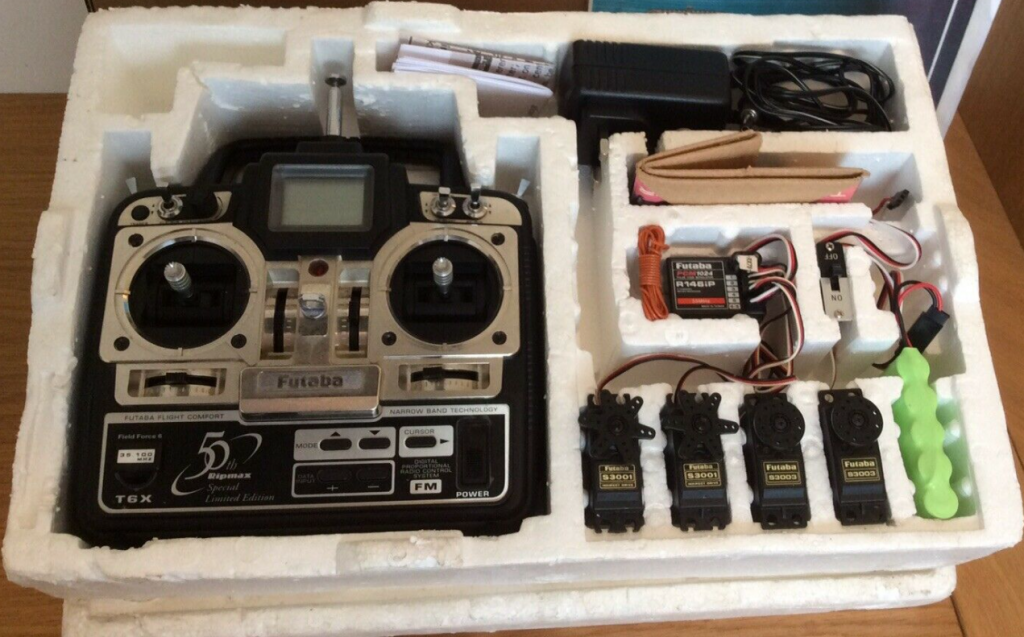

There are three radio frequencies for flight in the UK but only two with readily available gear these are the 35 Mhz and 2.4 Ghz bands there are other radio frequencies for Radio Control, but these are for surface models only and cannot be used for aircraft.
35 Mhz is now being superseded by the 2.4 Ghz equipment but quite a few modellers still use the 35 Mhz band as they have a shed full of planes all on 35 Mhz and have no reason to change.
The newer 2.4 Mhz band is a lot better with less interference issues from other users or equipment and it makes it a reliable option for flight.
If you are just entering the hobby and need to buy, then 2.4 Ghz is the way to go. But before you make any purchase speak to the members of Bretons for their advice.
Learning at Bretons
All the training is done with the buddy system which means you will need two transmitters compatible with each other.
One transmitter is operated by the instructor that transmits and control the aircraft the other is used by the student and does not transmit but is connected to the transmitter held by the instructor.
With this method the instructor can give and take back control as required.
It is not a practical situation to rely on someone else’s transmitter as there are so many different models and makes that may not work together also you always know that both have the same settings, so it is far better to have 2 transmitters of the same make and model along with a buddy lead for the specific transmitters.
I brought my buddy transmitter second hand online thinking I can always resell it when I did not need it anymore and get my money back but be warned if you go down this route if the second transmitter needs repairing this cost need to be factored in.
Any of our instructors will best advise you with regards to this so please ask them before you make any purchase as it could save you a lot of money and headaches in the long run.
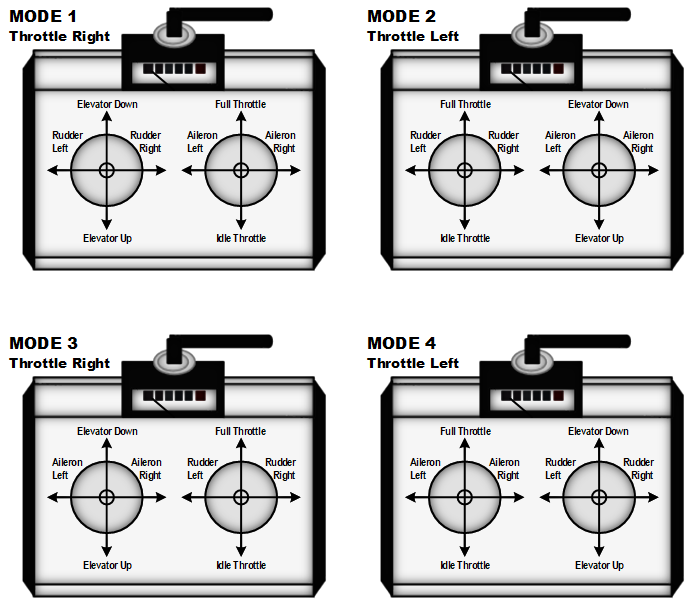
There are four different modes for transmitters but normally in the UK only two are used:
Mode 1 where the throttle is on the on the right-hand side
Mode 2 where throttle is on the left-hand side.
Unlike many other clubs there is no restriction on whether you use mode 1 or mode 2 at Bretons Model Flying Club as we have instructors available for both modes.
You will be best advised to speak to the instructor that you will learn with before buying your transmitter on which mode would be most suitable for you as later on when flying on your own if you are using Mode 2 and if everyone else on the field is using Mode 1 and you run into problems you may not be able hand your transmitter to someone else to help you out.
Most transmitters these days can be converted quite easily and quickly from one Mode 1 to Mode 2 but check before purchasing.
The transmitters come all sort of bells and whistles when training keep it simple and cheap is ok.
Your training aircraft will require 4 channels so a good starting point is a 6-channel transmitter and receiver as this will be sufficient for your learning time and also then you will then be able to use it after that with your next aircraft and possibly depending on your choices or what you wish to fly over the forthcoming years be the only one you may need.
There is a good choice of six channel gear, and it will give you a bit more flexibility it will probably be years before you need to upgrade.
The receivers need to be compatible with your transmitter but any of the club members can advise and assist you with what receiver(s) will work with what transmitter so ask before you buy as it could end up saving you a lot of money.
The First Flight
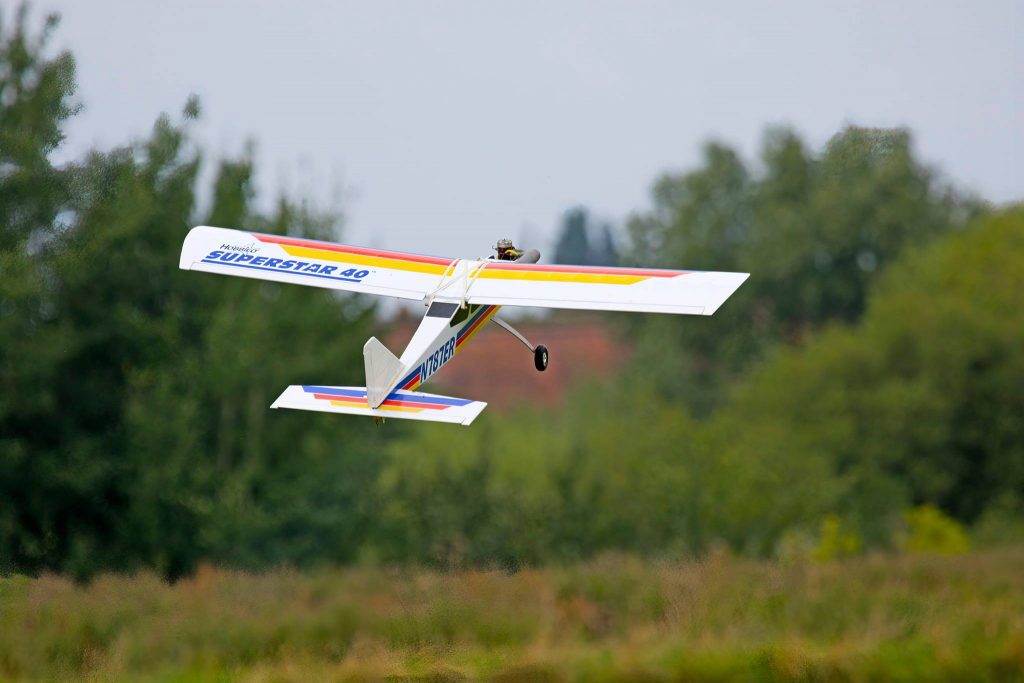
With the help of club members and having now got my trainer aircraft, two transmitters and all other bits required now acquired and assembled I was ready for the first day or learning.
On my first day there were two instructors at the field they explain about safety and inspected my aircraft.
After checking the transmitter and all controls are working, they found that I had small problems with the aircraft and with their help the problems were solved.
It was also recommended that the propeller should be changed a propeller appeared from someone’s flight box and we were ready to go.
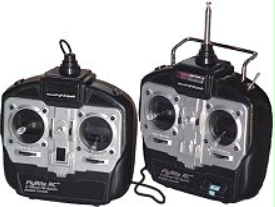
At Bretons Model Flying Club all flight training is done on a buddy system where two transmitters are used. The instructor uses the master, and the student uses a slave transmitter, and they are both connected by a buddy lead.
This allows the instructor to do the tricky bits like taking off and landing making the whole process easy and safe and being able to take over control of the aircraft at any time it is needed then hand it back to the student.
So, with one instructor on the master and the other on the slave the airplane was on its maiden flight all trimmed out, they made sure all is ok and that is was safe and ready to use for learning.
With a bit of tinkering, we were all ready to go.
Over the coming weeks I had many flights with most of the instructors and all with a different style of flying and instructing making the whole process much more interesting and enjoyable and quite possibly giving a better level of learning.
On my first few flights the instructors did all the take-offs and landings then handed control over to me when it was safe and taking back control if I started running into problems.
All the training at Bretons Model Flying Club is done to the current (BMFA) standards and requirements with the aim of you being able to take your examination and gain the “A certificate” that is recognised by all flying clubs in the UK of your ability to fly and which also means you are competent and safe to fly solo.
All the flight training is very relaxed and done at your own pace for the first few flights it is a case of just trying to keep the thing in the air.
After a while, things started to come together getting more and more to achieve the desired controlled flight.
Becoming more proficient I moved on to take offs, landings, fly left and right circuits, figure of eight course and dead stick landings (land without engine power – essential in the event of an engine failure).
The process is very comprehensive, but it is surprising how quickly you can learn whilst you are enjoying yourself.
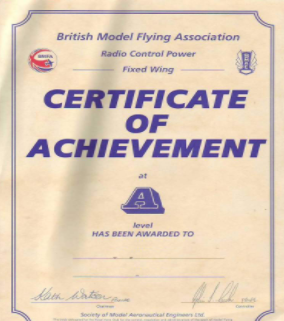
With enough practice will soon be ready for you to take the BMFA ‘A’ certificate test to allow you to fly solo.
The test consists of a couple of flights so you can demonstrate your ability to fly a controlled safe flight then answer a few questions from the Members Handbook then you are ready to fly solo.
You can then the look forward to many happy days in good company flying to your heart’s content.
This article has been kindly written by Dave Restell, one of our club members and hopefully gives you an insight into the basics but please before you join any club or buy any equipment firstly come visit and speak to club members and instructors.